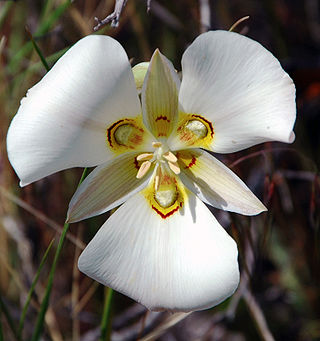
Calochortus is a genus of flowering plants in the lily family. The group includes herbaceous, perennial and bulbous species, all native to North America.

Calochortus nuttallii, also known as the sego lily, is a bulbous perennial plant that is endemic to the Western United States. The common name of sego comes from a similar Shoshone word. It is the state flower of Utah.

Cycladenia humilis is the sole member of the monotypic genus Cycladenia. Known by the common name Sacramento waxydogbane, it is an uncommon plant native to the southwestern United States. Collections have mostly been from California, although the species has also been reported from Utah and Arizona, mostly on gypsum soils. It is found at some elevation in several mountain ranges in the region. One of the four varieties of this plant, called the Jones waxydogbane, is considered a threatened taxon. This is a fleshy perennial herb with dull green leaves and pinkish lavender flowers. The flowers begin as rolled tubes shaped like pea pods and then open into colorful funnel-shaped blooms.

Calochortus amabilis is a species of the genus Calochortus in the family Liliaceae. It is also known by the common names Diogenes' lantern, yellow globe-tulip, golden globe-tulip, yellow globe lily, golden fairy lantern, golden lily-bell, Chinese lantern, and short lily.
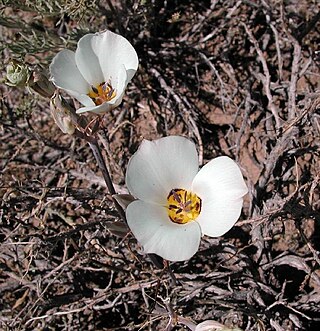
Calochortus bruneaunis is a species of flowering plant in the lily family, and is known by the common name Bruneau mariposa lily.

Calochortus elegans is a species of flowering plant in the lily family known by the common name elegant Mariposa lily, cat's ear, elegant cat's ears or star tulip. It is native to the western United States from northern California to Montana.

Calochortus excavatus is a species of flowering plant in the lily family known by the common name Inyo County star-tulip.

Calochortus leichtlinii is a species of flowering plant in the lily family known by the common names Leichtlin's mariposa, smokey mariposa, and mariposa lily.

Calochortus nudus is a North American species of flowering plant in the lily family known by the common name naked mariposa lily.
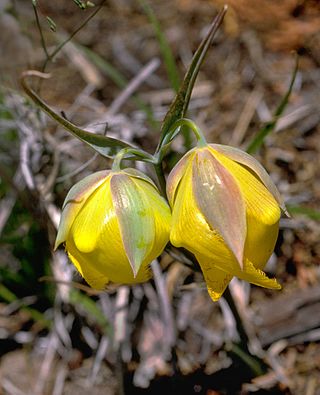
Calochortus raichei is a rare species of flowering plant in the lily family known by the common name Cedars' fairy-lantern. It is endemic to Sonoma County, California, where it is known only from The Cedars, an unincorporated area outside Guerneville north of Cazadero, just west of Austin Creek State Recreation Area.

Hesperidanthus barnebyi, syn. Schoenocrambe barnebyi, is a species of flowering plant in the mustard family, known by the common names Barneby reed-mustard, Syes Butte plainsmustard, and Barneby thelypody. It is endemic to Utah in the United States, where it is known only from Emery and Wayne Counties. It is threatened by habitat degradation and destruction. It is federally listed as an endangered species of the United States.
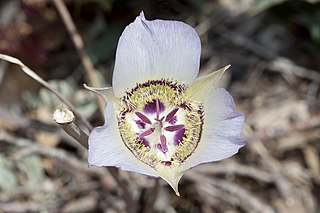
Calochortus ambiguus, the Arizona mariposa lily or doubting mariposa lily, is a perennial plant in the lily family (liliaceae) that grows at higher elevations of the Sonoran Desert regions of Arizona, western New Mexico, southern Utah, and Sonora.
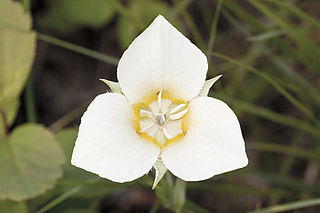
Calochortus apiculatus is a North American species of flowering plants in the lily family.
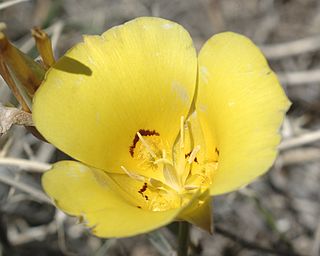
Calochortus aureus is a North American species of flowering plants in the lily family. It is native to the southwestern United States. Calochortus aureus is a bulb-forming perennial herb producing a single stalk up to 30 cm tall. Flowers are bright lemon-yellow with red or purple splotches on the petals.

Calochortus eurycarpus is a North American species of flowering plant in the lily family. It is native to the western United States: Montana, Idaho, eastern Oregon, western Wyoming, northeastern Nevada and southeastern Washington.

Calochortus gunnisonii commonly known as Rocky Mountain mariposa or Gunnison mariposa lily is a North American species of flowering plant in the lily family. It is native to the western United States, primarily in the Rocky Mountains and Black Hills: Arizona, New Mexico, Utah, Colorado, Wyoming, Montana, South Dakota, Washington state (Grant County, northwestern Nebraska and eastern Idaho.

Calochortus longibarbatus is a species of flowering plant in the lily family with the common names long-haired star-tulip and longbeard mariposa lily. It is native to Oregon, Washington, and northern California, where it grows in the forest and woodlands of the mountains.

Calochortus lyallii, or Lyall's mariposa lily, is a North American species of flowering plant in the lily family. It is native and endemic to Province of British Columbia in western Canada, as well as the State of Washington in the northwestern United States. It only grows east of the Cascade crest in the mountains and foothills, and though its numbers are apparently secure in Washington, it is considered to be a blue-listed species in Canada- blue-listed taxa are at risk, but are not extirpated, endangered or threatened. It is found in dry to mesic open forest at lower to middle elevations in the mountains, commonly found with Pinus ponderosa, Pseudotsuga menziesii, Calamagrostis rubescens (pinegrass) and Carex geyeri.
Gutierrezia petradoria is a species of flowering plant in the family Asteraceae known by the common names San Pedro snakeweed and goldenrod snakeweed
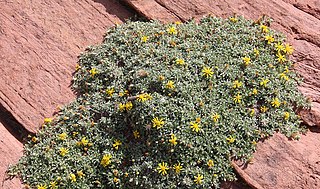
Heterotheca jonesii, known by the common name Jones's goldenaster, is a rare North American species of flowering plant in the family Asteraceae. It has been found in the southern part of the state of Utah in the United States.

















